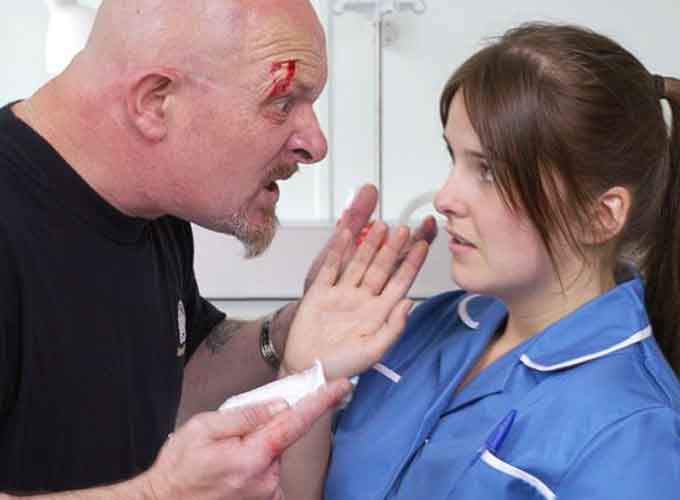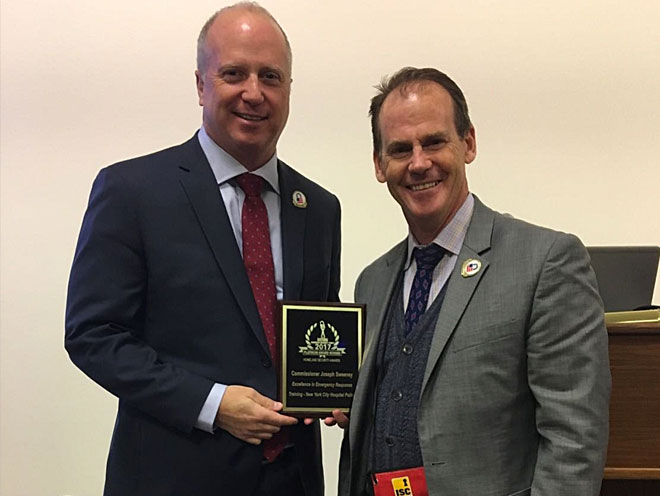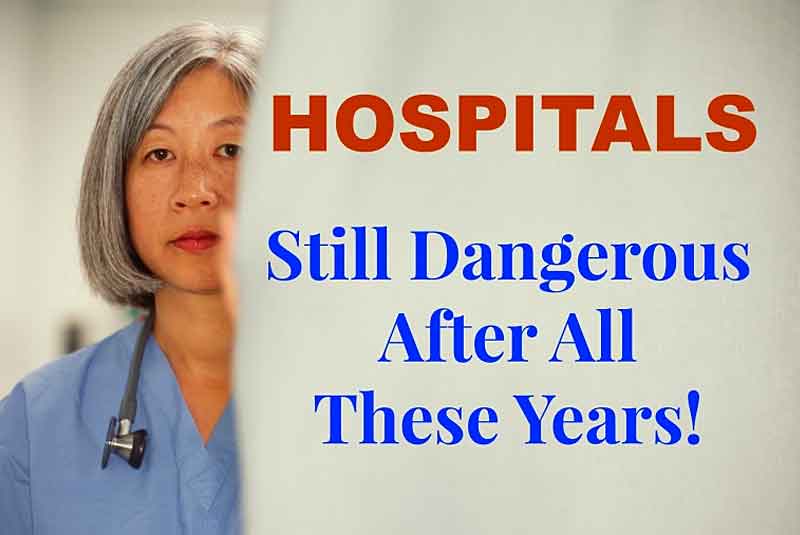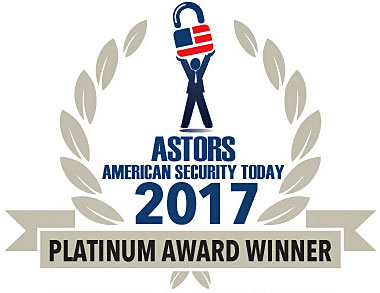
Guest Editorial by Thomas Egan, Director of Security and Hospital Police, NYC Health + Hospitals, and a 2017 ‘ASTORS’ Homeland Security Award Winner.
We have a workplace violence problem in healthcare that goes way beyond the debate of whether we should arm security in our hospitals.
Despite some evidence that gun violence is on the rise in our facilities[1], a bigger problem is violence without guns; physical assaults, threats of violence and harassment that harm our service providers and make it hard for them to come to work every day.
The problem is so pervasive that The Joint Commission recently released a ‘Sentinel Event Alert’ to bring attention to the problem, going so far as to say that healthcare facilities that have earned a gold seal (the highest honor they bestow) will find their status in jeopardy if their workplace violence prevention program is not adequate.[2]
(Watch this powerful investigative report about the epidemic of workplace violence against nurses and health care workers at the Worcester Recovery Center and Hospital. This is why we need to pass legislation to require ALL health care providers to develop and implement plans to prevent workplace violence. Courtesy of Fox 25, Just Ask About Patient Safety and YouTube. Posted on Oct 1, 2015.)
The cost of workplace violence to our healthcare industry is estimated at 2.7 billion dollars.[3]
More productive hours are lost to workplace violence in healthcare, than any other industry and the number of work hours lost to workplace violence in healthcare is almost equal to all other industries combined. [4]
These conditions are a clear detriment to the healthcare industry and to emergency medicine in particular.
One OSHA publication reported that the national average for injuries caused by assault is 3%, but for healthcare workers, it’s 10-11%.[5]
Another reported that 80% of all healthcare worker injuries came at the hands of the very people they are trying to help, patients.[6]
(Learn More. The ALICE Training Institute has changed models from Instructor Led Training to Blended Learning. Blended learning combines the effectiveness of hands on drills from Instructor Led Training, with the fast, easy, and consistent instruction of e-Learning. This model helps organizations implement ALICE faster, across the whole organization, and with a consistent message, by providing everyone with their own e-Learning course.Courtesy of the ALICE Training Institute and YouTube. Posted on Feb 9, 2016.)
A 2014 survey by the American Nurses Association revealed that 25% of all nurses had been physically assaulted by a patient or a family member of a patient.[7]
These statistics tell a tragic story.
While healthcare workers throughout the United States have been enduring Workplace Violence, change is coming too slow for them.
Attacking a nurse or other healthcare worker is still not a felony in six states[8] and there is no National standard to workplace violence prevention, a void that The Joint Commission is trying to fill.
(Security video released shows exactly what happened when a hospital patient attacked nurses with a metal pipe. He later died after being handcuffed by police. Courtesy of USA TODAY and YouTube. Posted on Nov 7, 2014.)
While national headlines about ‘active shooter’ incidents and other rampage killings, nurses and their colleagues are toiling under a real threat that does not get the same attention or the headlines.
In 2006, The New York State Department of Labor enacted legislation that required all public employers to implement programs to address workplace violence.
The Joint Commissions involvement comes a full 12 years after this. It’s a good start, but there is still plenty of work to do in this area.
(Nurses say they won’t stay silent any longer about violence from patients. Courtesy of CBS Los Angeles and YouTube. Posted on Nov 12, 2015.)
It is safe to say that a healthcare facility is a difficult place to work, our customers are the sick and the injured, the friends and family of the sick and the injured, and the people that care for the sick and the injured.
Every instance of violence is like stacking bricks on a healthcare worker’s back, they probably can handle it better than most, but the pressure is building, and we owe it to them to do everything we can to alleviate that pressure before it breaks them.
2017 ‘ASTORS’ Homeland Security Awards Program

Commissioner Joseph Sweeny, and Deputy Commissioner Thomas Egan, of the New York City Hospital Police were Recognized in the 2017 ‘ASTORS’ Awardsfor Excellence in Emergency Response Training for Security Hospital Teams.
AST focuses on Homeland Security and Public Safety Breaking News, the Newest Initiatives and Hottest Technologies in Physical & IT Security, essential to meeting today’s growing security challenges.
-
Commissioner Joseph Sweeney, NYC HHC
- New York Hospital Police
- Bellevue Hospital
-
Excellence in Emergency Response Training
-
Deputy Commissioner Thomas Egan, NYC HHC
- New York Hospital Police
- Bellevue Hospital
-
Excellence in Emergency Response Training
The 2018 ‘ASTORS’ Homeland Security Awards Program, is organized to recognize the most distinguished vendors of Physical, IT, Port Security, Law Enforcement, Border Security, First Responders, (Fire, EMT, Military, Support Services Vets, SBA, Medical Tech) as well as the Federal, State, County and Municipal Government Agencies – to acknowledge their outstanding efforts to ‘Keep our Nation Secure, One City at a Time.
To Learn More about the ‘ASTORS’ Homeland Security Awards Program, see 2017 ‘ASTORS’ Homeland Security Award Winners Honored at ISC East.

Over 100 distinguished guests from National, State and Local Governments, and Industry Leading Corporate Executives from companies allied to Government, gathered from across North America and the Middle East to be honored from disciplines across the Security Industry in their respective fields which included representatives from:
 The Department of Homeland Security
The Department of Homeland Security- U.S. Customs and Border Protection
- The Department of Justice
- The Security Exchange Commission
- State and Municipal Law Enforcement Agencies
- The Royal Canadian Mounted Police
- Leaders in Private Security
American Security Today will be holding the 2018 ‘ASTORS’ Awards Presentation Luncheon to honor Nominees, Finalists and Winners on November 14, 2018 at ISC East 2018 in New York City.
Nominations are now being accepted for the 2018 ‘ASTORS’ Homeland Security Awards at https://americansecuritytoday.com/ast-awards/.
For ‘ASTORS’ Sponsorship Opportunities and More Information on the AST 2018 ‘ASTORS’ Homeland Security Awards Program, please contact Michael Madsen, AST Publisher at: mmadsen@americansecuritytoday.com or call 732.233.8119 (mobile) or 646-450-6027 (office).
[1] 2000 to 2017 Active Shooter Incidents. FBI Documents. https://www.fbi.gov/file-repository/active-shooter-incidents-2000-2017.pdf/view
[2] Sentinel Alert 59: Physical and Verbal violence against healthcare workers. April 17, 2018. The Joint Commission. Retrieved from: https://www.jointcommission.org/assets/1/18/SEA_59_Workplace_violence_4_13_18_FINAL.pdf
[3]Tuohey, K. (2018). OSHA: focusing on healthcare’s continuing increase in workplace violence. Journal of Healthcare Protection Management, 34(1), Page 44
[4] Tuohey, K. (2018). OSHA: Page 43.
[5] Preventing workplace violence: Caring for our caregivers. December 2015. OSHA. Retrieved from https://www.osha.gov/Publications/OSHA3827.pdf.
[6] Workplace Violence in Healthcare: Understanding the Challenge. November 2015. OSHA Retrieved from https://www.osha.gov/Publications/OSHA3826.pdf.
[7] Almendrala, Anna. Violence Against Nurses is a Serious Problem, But Hospitals are Basically Policing Themselves. Huffington Post. Sept. 14, 2017. Retrieved from https://www.huffingtonpost.com/entry/violence-nurses-hospital-responsibility_us_59bad5a3e4b02da0e1404e47.
[8] 50 State Survey Criminal Laws Protecting Health Professionals. On Labor.org. Updated January 2014. Retrieved from https://onlabor.org/wp-content/uploads/2016/03/StateLawsWorkplaceViolenceSheet.pdf.
Learn More…
Hospital Security: To Arm, Or Not to Arm (Learn More, Multi-Video)


















